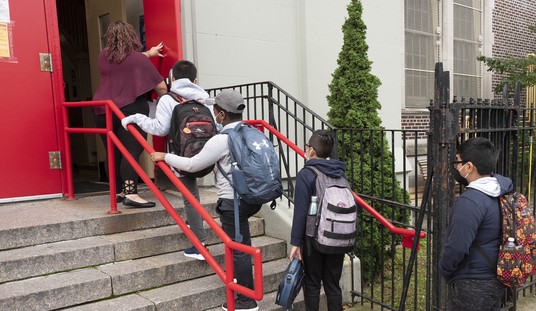Ohio has bragging rights as the top state for regulating prescription drugs. Via AP:
The American Medical Association has listed Ohio as the top state when it comes to monitoring prescription drugs.
The AMA says in a recent fact sheet that Ohio processed more than 24 million queries from doctors and other health professionals through the Board of Pharmacy’s Ohio Automated Rx Reporting System.
The state created the system to track the dispensing of controlled substances and monitor suspected abuse. OARRS has been a key tool in battling the state’s deadly addictions epidemic.
But is it working? Doesn’t look like it. According to the CDC, the state saw a 21.5 percent increase in overdose deaths from 2014 to 2015. Only six states had higher increases. The Buckeye State had a staggering 3,310 deaths in 2015, making it the second-worst state in the nation. Ohio’s 29.9 drug overdose deaths per 100,000 people earned the state a spot near the top of the national chart, behind only West Virginia and New Hampshire with 41.5 and 34.3 deaths per 100,000, respectively.
Gov. Kasich’s answer to these devastating statistics is to make it harder for people to get their hands on prescription opioids. He recently issued an executive edict limiting opioid prescriptions to seven days (five days for minors) for acute conditions.
“You are going to have to abide by these rules or else you’re in serious trouble, whether you’re a doctor, a dentist or a nurse,” he warned.
Warnings like this, while well-intentioned, hurt law-abiding citizens who now often suffer in pain because they can’t get the meds they genuinely need for legitimate health problems. Opioid pain medications can be safe and effective for treating pain when used appropriately, but increased regulations on these drugs as a result of the heroin epidemic have made it monstrously difficult for those with chronic pain to get the drugs they need. I’m always shocked to hear about the huge quantities of prescription opioids that addicts were able to obtain, because for most people who follow the rules, quantities are strictly limited, and they require regular follow-up visits with a physician. Doctors are being threatened to within an inch of their medical licenses if they get caught over-prescribing (which, again, makes me marvel that anyone is able to obtain enough opioids—legally—to abuse them).
But the fears may be overblown. As Karl Herchenroeder reported here at PJM recently:
A common narrative cited in discussions about the opioid crisis – that a medical patient is prescribed painkillers, gets addicted and dies of an overdose – is a myth, an expert on the topic argued Wednesday.
During a discussion at the Cato Institute, Phoenix-based general surgeon Jeffrey Singer cited studies from the Centers for Disease Control and Prevention, JAMA Psychiatry and various municipalities supporting his claim. According to the CDC, the opioid-related overdose death rate for patients prescribed pain medication by doctors is 0.2 percent. A 2014 JAMA study showed that out of 136,000 patients treated for opioid overdoses in emergency rooms around the country, 13 percent involved chronic pain patients.
And though the U.S. recorded 33,000 opioid-related overdose deaths (including heroin) in 2015, Singer said that the vast majority of those deaths can be attributed to people mixing narcotics with other substances. New York City reported in 2013 that 94 percent of its residents who died from heroin or opioid abuse had multiple drugs in their system.
“It’s not like doctors are prescribing a painkiller for a patient in pain, who then gets hooked and becomes a heroin addict. That’s not the usual way,” Singer said.
Dr. Lynn R. Webster, a physician who has treated chronic pain patients for more than 30 years, says that new rules issued by the Drug Enforcement Administration (DEA) limiting access to hydrocodone are inflicting harm on chronic pain patients. The new restrictions, which include a decision to relabel hydrocodone as a Schedule II drug, require that patients jump through burdensome hoops in order to receive the medication they need. Patients must see their physician every 90 days in order to receive refills, and doctors can no longer call in prescriptions. “Pain advocates across the country were vocal when the DEA announced these changes,” Webster wrote. “They would have unintended consequences that would hurt, rather than help, legitimate pain patients in need.”
She cited a survey by the National Fibromyalgia and Chronic Pain Association (NFMCPA) that assessed the regulatory changes. The survey found that:
- 88 percent of patients felt that the changes denied their rights to access pain medication
- 71 percent report being switched to less effective medications by their doctors, who are fearful of legal issues
- 52 percent felt an increased sense of stigma as a patient receiving hydrocodone
- 27 percent of patients even reported suicidal thoughts when unable to access their prescription
“Controlling the abuse and overuse of pain killing drugs is necessary to keep patients safe, but the importance of decreasing drug abuse does not outweigh the needs of millions of people who suffer from chronic and depleting pain,” Webster explained. “When patients who suffer from these excruciating conditions are denied access to medication, they often turn to alternative forms of relief such as black market drugs, creating a larger issue of abuse.”
I suffer from chronic, often debilitating migraine headaches and have experienced firsthand the effects of the national war on opioids. I’ve been to doctors who refuse to prescribe any pain meds for migraine patients. The reason? Pain meds never help migraine pain, I was told, which is complete bull hockey. I’ve also been to practices that have a policy of not prescribing opioids to anyone for any condition. Unfortunately, it seems that for many doctors, it’s easier to just deny pain meds outright to all patients than to risk some becoming dependent. While opioids may not be the most effective treatment for migraines, and they may be contraindicated in some (even many) cases, saying that they “never” help migraine pain is verifiably false.
In my case, I’ve found that while strong pain medications like Percocet won’t take a migraine away completely, they’ll sometimes buy me a few precious hours of respite from the blinding pain. That’s why I’m willing to drive an hour to a migraine clinic with doctors who recognize that opioids can and do play a vital role in managing this type of chronic, debilitating pain. It wasn’t too many years ago that I was able to go to my family doctor’s office (or sometimes his home!) for a shot of Demerol to get me through an especially bad migraine episode, but now patients in pain are forced to go to the emergency room for relief (which again leaves me wondering where people are getting all these pills).
But going to the ER is one thing I won’t do when I have an excruciating, intractable migraine, even one that has gone on for a week with no end in sight, accompanied by constant vomiting. Migraine patients who show up at the ER are treated like drug addicts these days, thanks to the culture of fear that surrounds opioid abuse. Even if I tell them at the outset that I don’t want narcotics and say that I just need some (non-narcotic) DHE by IV, I’ll still be treated like a drug-seeking junkie. I’d rather suffer at home than under the bright lights at the ER with nurses searching my arms for needle marks and then leaving me languishing for hours on a stretcher, vomiting into the wastebasket, only to be sent home in worse shape than I arrived.
I’m no libertarian on drug policy, but I do support treating doctors like the trained professionals they are, which includes giving them a full arsenal of tools at their disposal to help patients who are suffering. (Yes, that includes medical marijuana.) It’s tragic that three thousand people a year die of drug overdoses in Ohio (and ten times that nationwide). But it’s also terrible that innocent chronic pain patients have to suffer and pay the price for the poor decisions of the minority of opioid users who go on to abuse drugs.










Join the conversation as a VIP Member